We have over 60 different coolers currently sitting in a storage unit that we have acquired over the past couple of years in an over-the-top effort to legitimately find the best coolers money can buy.
The abundant advertising and high price tags might make you think there is more to an ice chest than there really is. But fortunately, they’re really not that complicated and, while you can, you don’t have to spend a fortune to get a good one. High-end rotomolded coolers like YETI, RTIC, and Kong might make good sense for backcountry hunters who need to keep 300 pounds of meat cool for a week with little ice, but there are less expensive options that do the job just fine for tailgates and beach days.
Out or more than five dozen coolers that I have thoroughly vetted, one of these ten will likely suit just about any outdoor fun-haver. But if you’re still not satisfied, be sure and check out our more curated reviews like the best coolers with wheels.
After you scroll through our top picks, be sure to read on about how we tested, how to choose your next cooler, and all the geeky data and analysis from our research.
EDITOR’S NOTE: This cooler review was entirely revised and republished on May 10, 2024 by Chase Fly in order to include currently available products, remove discontinued ones, and provide more insight into how these bad boys (and girls) were tested.
DISCLOSURE: As an Amazon Associate I earn from qualifying purchases. Many links in this article are affiliate links. If you click on a link we may earn a commission if you make a purchase, at no additional cost to you.
The Best Coolers of 2024
- Best Overall Hard Cooler: Maluna 70
- Most Versatile: Orion Core 65
- Also Great: Orca 58
- Best with Wheels: BrüMate BrüTank 55
- Best YETI: YETI Roadie 48
- Budget Pick: Coleman 316 Series 62 Qt Wheeled
- Best Small: Coho 24 Qt Injection Molded
- Best Soft: Cordova Backcountry Class Daypack
- Best Backpack: ICEMULE Pro Large
- Most Innovative: Oyster Tempo
Just so you know, of the 60+ coolers we have at Outdoor Empire, roughly a quarter of them were sent to us as media test samples with no strings attached, meaning we didn’t pay for them but we can still say (or not say) whatever we want about them. We purchased the rest at regular retailers and prices like anyone else. Of the coolers covered in this buyer’s guide, the Orion, Orca, and Oyster were sent to us for free. We treat and test all gear the same, regardless of how we acquire it, and there are no paid placements or sponsors in this review.
Here are some things I have discovered while searching for the best cooler for camping, hunting, fishing, tailgating, the beach, or simply sneaking in booze where it’s not welcome.
- The best cooler probably comes from a brand most people haven’t heard of.
- Everyone expects different things from a cooler. The best one for you may not be the best one for my mom, which is why I offer several suggestions below.
- There are coolers at every price point that can retain ice for far longer than most people will ever require.
- Gear review sites like us can’t earn affiliate commissions on some of the top performers. We don’t mind, but that may be why you don’t see some of our top picks in the 1,652,347 other Best Cooler articles on the web.
1. Best Overall Hard Cooler
Maluna 70
Outdoor Empire Score 4.9
Ice Retention 5 | Build Quality 5 | Durability 5 | Features 4.5 | Warranty and Service 5
Pros
- Best insulation and ice retention
- Extra durable
- Easy to use latches and lid
- King of the fundamentals
Cons
- Heavy and bulky
- Hard to move around by yourself
- Lacks aftermarket accessories
The reason I picked the Maluna 70 as the best overall hard sided cooler is because it nails the fundamentals. It handily won my ice retention challenge where I bought 1700 pounds of ice and tested 38 coolers simultaneously. It was mild weather, but the Maluna held ice for 17 days! It beat the Cabela’s Polar Ice Cap by one day and the next two coolers on this list (Orion and Orca) by 3 full days.
While I wouldn’t expect that kind of ice retention in the dead of summer (you can bank on around 50% of that, based on my experience), the Maluna’s Unhinged design is built to optimize ice retention. A thick, 3-finned freezer gasket provides an air tight seal thanks to the self-tensioning rubber straps on the front and rear of the cooler which help apply even pressure around the entire lid. The ice box has a tapered shape because the insulation is thicker up higher where ice recedes and warm air typically prevails. They simply put more insulation where it matters most, and I found it to be quite effective.
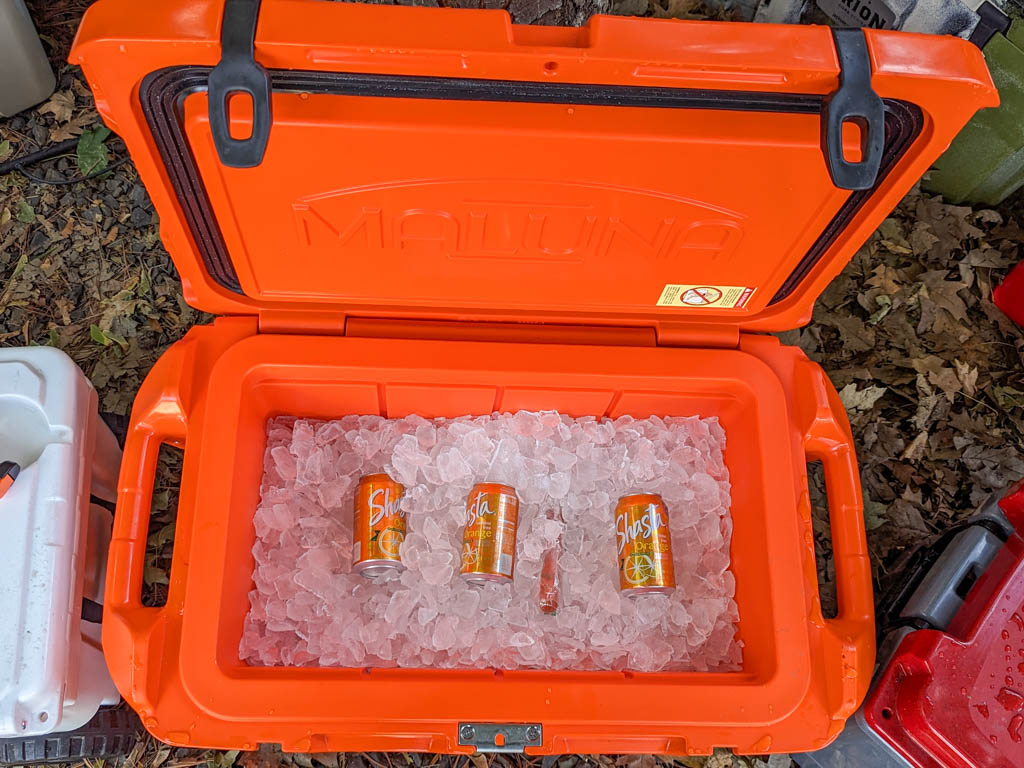
The Maluna checks all the boxes of what you should expect from a high-end cooler at a premium price point. Its rotomolded, thick plastic shell is not only durable but also feels high-quality. It’s internal capacity is 70 quarts, as advertised, which isn’t the case with every cooler. The Maluna is IGBC bear-resistant certified, having passed official testing and approval—I checked that personally. It also comes with an excellent lifetime warranty a few practical features like a bottle opener, a padlock hole, and a quick-flow drain.
This made in the USA cooler even has a built-in pressure regulator under the bottle opener. This makes it much easier to open the lid after a big elevation gain, like from your house to the mountains, which can make some air tight coolers a boar to pry open. The rubber latches are easier to use than many others and I personally like the molded handles on the sides compared to dangly ropes. They keep the cooler from dragging or banging against your shins when you carry it.
A downside of this cooler is that it’s heavy, though the same could be said for any rotomolded cooler. And if you’re interested in a lot of add-ons, accessories, or attachments, there are better options than the Maluna. You can get a basket for it, but no wheel kits or rod holders.
Who should get this? Hunters, anglers, rafters, and campers who take extended trips. In a smaller size, it’s a perfect back-of-the-truck cooler for farming, construction, and landscaping, keeping drinks and lunches cold while taking a beating and reducing ice costs. It’s also ideal for emergency preparedness to keep food cold at home for a long time. For better portability, consider the YETI Roadie 48, or for a cheaper option with good ice retention, look at the Coleman 316 Series.
2. Most Versatile Cooler
Orion Core 65
FYI, the link above is NOT an affiliate link, but Jackson Kayak did offer our readers a discount. Use code DYMFJ9TET571 at checkout for 5% Off!
Outdoor Empire Score 4.9
Ice Retention 5 | Build Quality 5 | Durability 5 | Features 4.5 | Warranty and Service 5
Pros
- Excellent ice retention even in summer
- Tons of fun, useful, optional add-ons
- Great value for the money
- Top-notch customer service
Cons
- No grip to open lid
- Latches may prevent lid from closing
Based on the Outdoor Empire score, the Orion Core 65 tied for the top spot. The Maluna broke the tie when it beat the Orion by a couple days in our ice challenge and by having a lifetime warranty. The Orion, however, is 15% less expensive than the Maluna and cheaper than half of the coolers on this list. It offers excellent value with premium cooler features like padlock holes, IGBC bear-resistant certification, a freezer-style gasket, rotomolded construction, and thick insulation. Plus, it has enough bottle openers (4) for a frat party and enough tie-down strap slots (6) for a covered wagon. Though what really sets the Orion apart as the most versatile cooler is all the optional add-ons you can get for it like accessory rails, rod holders, traction pads, and a well-designed wheel kit which I’m still hoping to get my hands on.
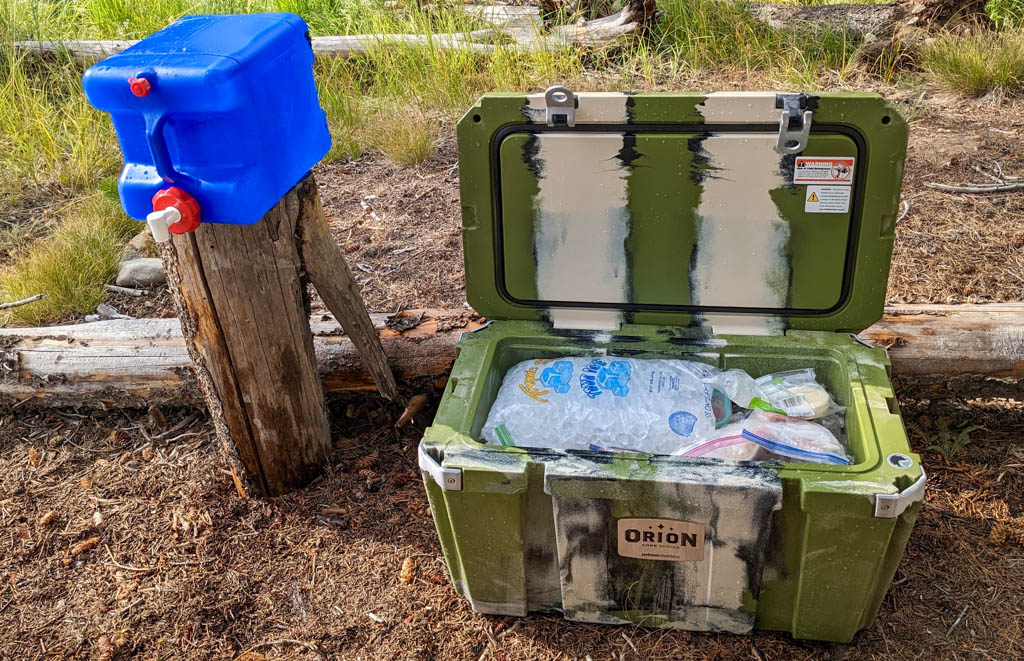
Orion delivers on its advertised capacity of 65 quarts, unlike some other cooler brands. The rope handles are perfectly sized to prevent banging your knuckles or dragging the cooler on the ground. The rubber latches with aluminum cams work well but occasionally prevent the cooler from closing, risking either smashing your fingers or letting cold air escape. I’m sure some folks will like the Maluna latches and handles better, though I still love the Orion’s. If you’re serious about one of these two coolers, take a moment to watch my YouTube video about them and think about your own personal preference on that.
The Orion is extremely durable—you can sit or stand on it, or even drop it on concrete. I’ve done all of that without leaving a mark. Jackson Kayak makes its Orion Core coolers in Tennessee where they make their famous kayaks. While not everyone will love their vibrant multi-color designs, I sure do. However, without a finger hold, opening the cooler’s lid can bend back fingernails and cause involuntary cursing. Pull up on the latch instead. Despite this minor flaw, it’s still a solid choice. In my blind customer service test, they responded within well under 24 hours (only about 1 business hour) with a friendly, personalized, and helpful answer to my inquiry.
Who should get this? Fishermen, especially kayak anglers, and people who do a lot of different things outdoors. It’s great for camping and could be made great for the beach with the add-on wheels. If you like customizing your truck, you’ll like the Orion cooler. For something easier to find that performs just as well but with fewer bells and whistles, look at the Orca.
3. Also Great
ORCA 58
Compare Prices: Bass Pro Shops, Sportsman’s Warehouse, Camp Saver, Walmart
Outdoor Empire Score 4.7
Ice Retention 5 | Build Quality 5 | Durability 5 | Features 4 | Warranty and Service 4.5
Pros
- Consistently excellent ice retention
- Stable to stand on or fish from
- Widely available
Cons
- Latches are hard to use
- Hard to carry
Where the Orca 58 cooler really excels is in ice retention. While it hasn’t won any of my ice challenges, it consistently finishes near the top despite being slightly smaller than those that beat it. It lasted 8 days in my hot weather ice challenge, only one day short of the Orion. But then it tied the Orion in the mild weather round. The Orca fans who commented on our YouTube videos also swear that it’s among the best. This cooler is as solid as a rock and can take a beating. It’s made in the USA, it’s sold in many retailers which makes it easy to find, and they offer a lifetime warranty on it.
I really like the more square shape compared to other more rectangular coolers. It makes it especially stable to stand on, so if you’re an angler who wants to use your cooler as a fishing platform on a boat or from shore, this is a good bet. The included cargo net on the back is also handy to throw in some fishing gear or stuff you don’t want to get buried in the sand at the beach. And the net material doesn’t feel cheap, it’s thick and durable and feels like it should last a long time.

Like other rotomolded coolers, the Orca is heavy and a bit burdensome to lug around, but the nylon handles on this one make it pretty easy with a partner. One downside is that the well-branded Orca tail latches are very hard to pull and use. This is good if you want to keep kids out of it, but bad if you don’t want to put out much of an effort to grab another cold one since it’s often a two-handed ordeal.
Who should get this? Serious campers, hunters, boaters, and anglers that want awesome insulation and maybe a platform to stand on. Convenience shoppers will appreciate that the Orca is easy to find in many different stores, even Walmart. For even better ice retention, consider the Maluna, or look at the YETI Tundra Haul for a similar wheeled alternative.
4. Best Wheeled Cooler
BrüMate BrüTank 55qt
Compare Prices: Scheels
Outdoor Empire Scores 4.5
Ice Retention 4.5 | Build Quality 5 | Durability 4 | Features 5 | Warranty and Service 4
Pros
- Feature-packed
- Lots of accessories included
- Top-shelf ice retention
- Easy to tow over most terrain
Cons
- Not bear-resistant certified
- Not ideal for hunting and fishing
The BrüMate BrüTank 55-Quart Rolling cooler dethroned my previous pick for the best cooler with wheels, the YETI Tundra Haul. The BrüTank offers way more value for a lower price and it holds ice longer. Even though it’s expensive, it comes with a bunch of extra stuff like a basket and foam seat top so you feel like you’re getting your money’s worth. But they didn’t leave out the bottle opener, padlock holes, or rugged design that everyone else offers, which now seem boring. It’s rotomolded and rugged with a high-end fit and finish. With quality components, a fat tethered drain plug 🙏, and beefy, easy-to-use latches, it simply looks and feels nicer than perhaps any other cooler I’ve seen.
Portability and fun are key functions of the BrüTank. It may not be compact or easy to fit in a small vehicle, but it offers enough capacity inside for anything from a day at the beach to an extended camping trip, while still being easy to move around. The tow handle is ergonomic with nice grips that extend outward so you can walk along side the ice chest and avoid getting bashed in the calves like you do with less thoughtfully designed wheeled coolers like the Pelican Elite. It also locks in place making both pushing and pulling a cinch. With its never-flat wheels that are just the right diameter and width, the BrüTank rolls easily over any terrain, even sand and rocks.
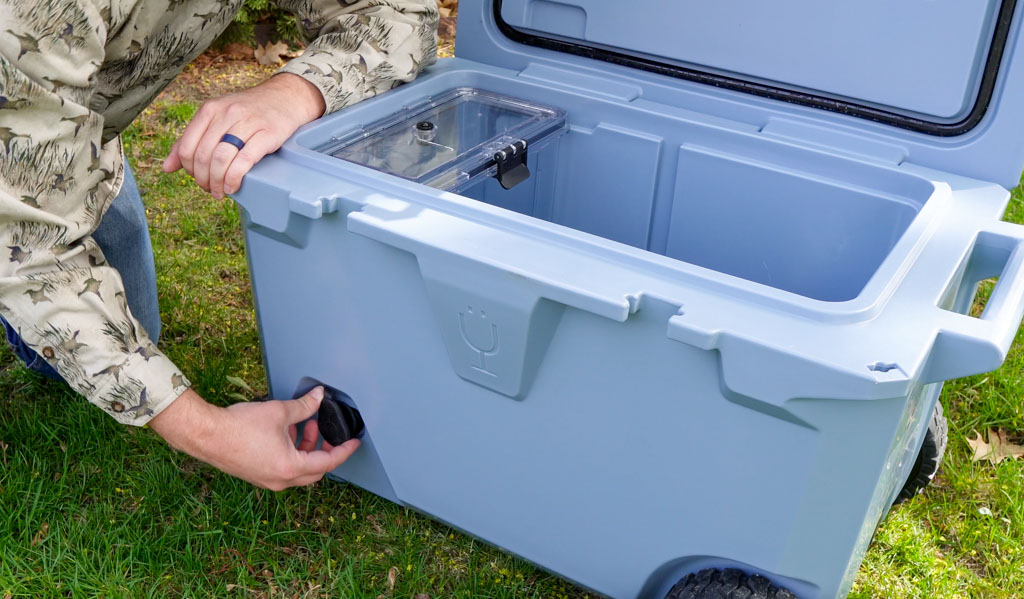
Perhaps the best thing about this cooler, though, is that it’s ready to party. The integrated 2.8 gallon drink tank with a tap on the outside and a pressure cap on top (to adjust the flow) means you can mix and chill your favorite drink inside next to the ice and snacks, then serve it directly from the cooler without opening the lid and letting all the cold air escape on a hot day. I don’t even like parties, but this cooler has me considering it.
Who should get this? People looking for a highly portable cooler primarily for social gatherings like beach days, parties, and sporting events. This works great for camping too. For a more compact wheeled cooler, consider the YETI Roadie 48, or look at the Coleman 316 Roller for a less expensive alternative.
5. Best YETI Cooler
YETI Roadie 48
Compare Prices: Sportsman’s Warehouse, Cabela’s, Bass Pro Shops, Academy Sports, Scheels, Sportsman’s Guide, Camp Saver
Outdoor Empire Score 4.3
Ice Retention 4.5 | Build Quality 5 | Durability 4 | Features 4 | Warranty and Service 4
Pros
- Excellent portability
- Best ice retention for size class
- Smooth wheels and tow handle
Cons
- Not IGBC bear resistant certified
- No way to lock it
YETI made an unprecedented move this year by dropping the price of some coolers, including the YETI Roadie 48, which now costs $50 less than I paid. While it’s priced similarly to the BrüTank (which is larger and comes with extra accessories), the Roadie 48 is still my favorite YETI cooler due to its impressive ice retention. In our 38-cooler ice challenge, the Roadie 48 outlasted any cooler in its size category and even several larger ones. It beat the Tundra Haul by two days in my test and even surpassed the Roadie 60 in other reports I’ve read. Its narrow, deep shape likely contributes to this outstanding performance.
Portability is another strong suit. The wheels roll smoothly over different surfaces, and its compact size fits into nearly any car. It’s lighter than the competition, and the side handles make it easy to lift. The retractable tow handle works smoothly and is sturdy enough to haul a full load without bending. This is a refreshing improvement over the likes of flimsy tow handles like what you find on the RovR RollR 45.
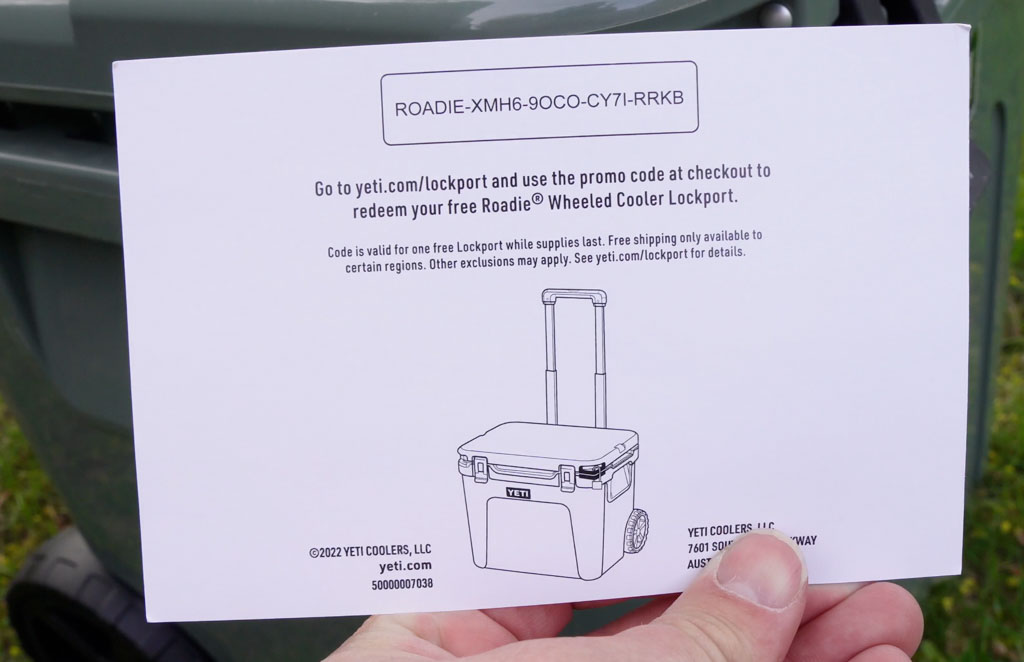
Some things that surprised me: it’s injection-molded, not rotomolded, which keeps it lightweight but isn’t the same as the Tundra series. It’s made in Thailand, not the USA, and isn’t IGBC bear-resistant certified, which won’t cut it in certain national parks and camping areas where that’s required.
The Roadie latches are far easier to use than the traditional Tundra latches and you still get the high-quality fit and finish expected from YETI. While the accessories are overpriced, the included dry goods tray is a nice touch. YETI’s 5 year warranty is average these days when competitors are offering 10 years or lifetime.
Who should get this? Die-hard YETI fans should get a Roadie 48 for its convenience and portability compared to the classic Tundra coolers. And for anyone who doesn’t mind the premium price tag, the Roadie is a great all-around cooler. Hunters and anglers are better off with something like the Maluna and if you camp in bear territory you should go with an IGBC approved cooler like the YETI Tundra Haul.
6. Best Budget Cooler
Coleman 316 Series 62 Quart Wheeled Cooler
Compare Prices: Walmart, Academy Sports
Outdoor Empire Score 3.1
Ice Retention 3.5 | Build Quality 3.5 | Durability 3 | Features 3.5 | Warranty and Service 2
Pros
- Affordable for most anyone
- Surprisingly durable
- Similar ice retention as expensive coolers
- Not a thief magnet
- Available at many big box stores
Cons
- Not bear resistant
- Lid doesn’t latch closed
- Lid doesn’t stay open easily for access
Don’t be alarmed by the lower Outdoor Empire score or the ice retention rank of the Coleman 316 Series 62-quart rolling cooler. The average price of the coolers I handpicked and tested after extensive research is $300, but this Coleman costs a fraction of that (I paid $60 at Walmart). Despite this, it lasted 9 days in our ice challenge, outperforming its advertised 6-day capacity.
If you’re shopping for a cooler under $100, you’re likely choosing between Coleman or Igloo. I’ve tested both brands, and the Colemans consistently outperform their Igloo counterparts in ice retention and durability. I’ve thrown this one off a truck onto asphalt and hurled it around to push its limits, yet it still looks almost new. Made in the USA and widely available at major retailers, I was impressed by the responsiveness of Coleman’s customer service when I contacted them anonymously. Although the one-year warranty is below average, Coleman once offered to replace my cooler even after the warranty expired.
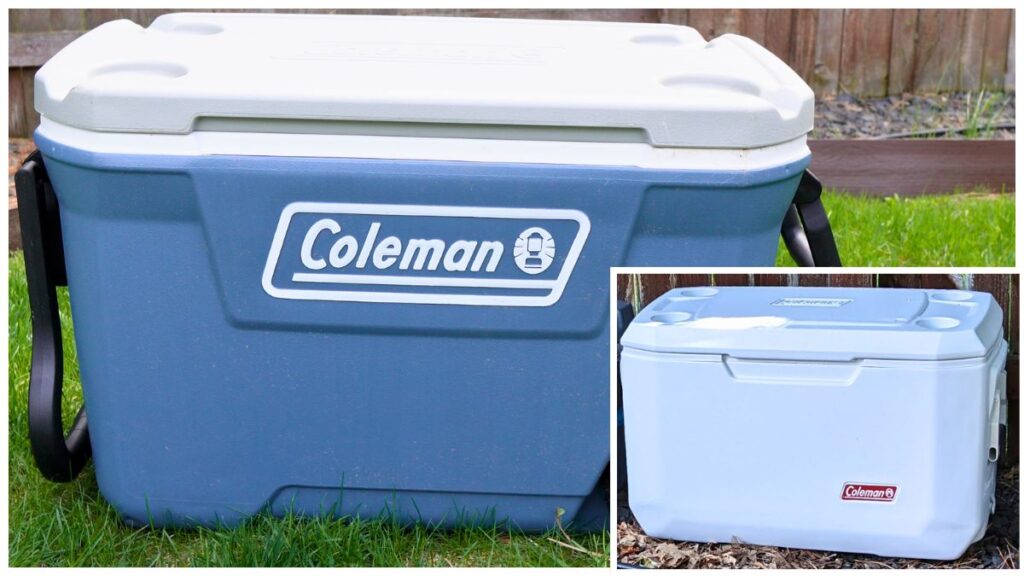
I have a couple of 316 Series coolers and what I love about them is that they provide more capacity with less weight and bulk than a rotomolded cooler. With over 60 coolers to choose from, you’d think we’d always pack a fancy one, but my wife favors this Coleman for its lightweight portability. From Costco grocery runs to kids’ sporting events, it gets used more than any other cooler I own. The wheels and tow handle work well enough, and its low price means no one will shed a tear if it gets banged up. Plus, it’s less likely to be stolen than a $400 YETI.
Who should get this? People who want cold food and drinks without forking out hundreds of dollars. Truth is, this cooler will do the job for the vast majority of folks. It’s great for sporting events, grocery runs, beaches, campouts, or anything else. If you need a budget-friendly bear-resistant cooler with wheels, consider the Lifetime High Performance ice chest.
7. Best Small Cooler for the Money
Coho 24 Qt Injection Molded Cooler
Link above is NOT an affiliate link, FYI.
Outdoor Empire Score 3.7
Ice Retention 3.5 | Build Quality 4 | Durability 4 | Features 3.5 | Warranty and Service 3.5
Pros
- Way cheaper than competition
- High quality construction
- Costco customer service
- Excellent insulation
Cons
- Limited availability
- Drain plug has to be extra tight to not leak
- Have to be a Costco member
The Coho 24 Qt Injection Molded cooler at Costco offers unbeatable value. It’s a direct competitor to the YETI Roadie 24, which costs over four times as much. Although injection molded coolers aren’t as thick or heavy-duty as rotomolded ones like the Orca, they’re still highly durable. I am intentionally rough on my coolers to identify which ones hold up the best, and so far, this Coho is a tank. Despite its beefy build quality, it’s still compact and easy to carry. The drain plug is rather robust as well, but I’m not convinced it’s necessary on a cooler of this size, and I had to really crank on it to prevent leaks. Another potential weak point is the plastic piece connecting the handle to the cooler body.
While I didn’t have this cooler during my last big ice challenge, I tested it alone in mild spring weather and it held ice for five days. I suspect in hotter conditions it will meet the advertised 3 days of ice thanks to its thick walls of dense closed cell insulation and freezer gasket, features you don’t usually find on coolers under $100.
The cam-style latches make it open with ease and they even managed to squeeze in useful extras like tie-down strap slots, a bottle opener, and padlock holes. Although not bear-resistant certified, it has all the makings of a high-end cooler. While I wasn’t impressed with the Coho rotomolded cooler from Costco which lagged in ice retention and durability within its category, this injection molded version rocks.
Who should get this? Couples, day trippers, and weekend warriors. Though it’s not large, this cooler holds enough drinks and meals for a weekend campout or a day on the job. If Costco membership isn’t for you, consider Cordova’s Basecamp 20-quart hard cooler, which is cheaper than a YETI, or the Backcountry Class soft cooler, which can work in similar situations as the Coho. But if you want to impress your friends, the Oyster Tempo ought to do it.
8. Best Soft-Sided Cooler
Cordova Backcountry Class Daypack
Compare Prices: Scheels
Outdoor Empire Score 4.6
Ice Retention 5 | Build Quality 5 | Durability 5 | Features 5 | Warranty and Service 3
Pros
- Excellent build quality
- Impressive ice retention for a small soft cooler
- Useful features like molle loops and bottle opener
- Reasonably priced
- Portable convenience
Cons
- Only 1 year warranty with lots of red tape
- Lid fits a bit loose
- Unsure about long term durability of zipper
The Cordova Backcountry Class Daypack soft cooler offers excellent value from a brand based right here in Idaho like Outdoor Empire. It’s particularly impressive when compared to its main competitors, the RTIC Soft Pack ($119) and the YETI Hopper Flip ($300). Cordova combines the best of both worlds, affordability and all the features. It includes the molle loops like the YETI, an external pocket more functional than the RTIC’s, various carrying options (butterfly handle, side handles, shoulder strap), and an attached bottle opener, which the other two lack.
Its design not only looks cool, but it kept ice cool for three full hot summer days. Only the larger Engel HD30 outperformed it, which is nearly twice as big and started with more ice. The zipper is easier to pull than the RTIC’s and it’s watertight to prevent leaking in your car.
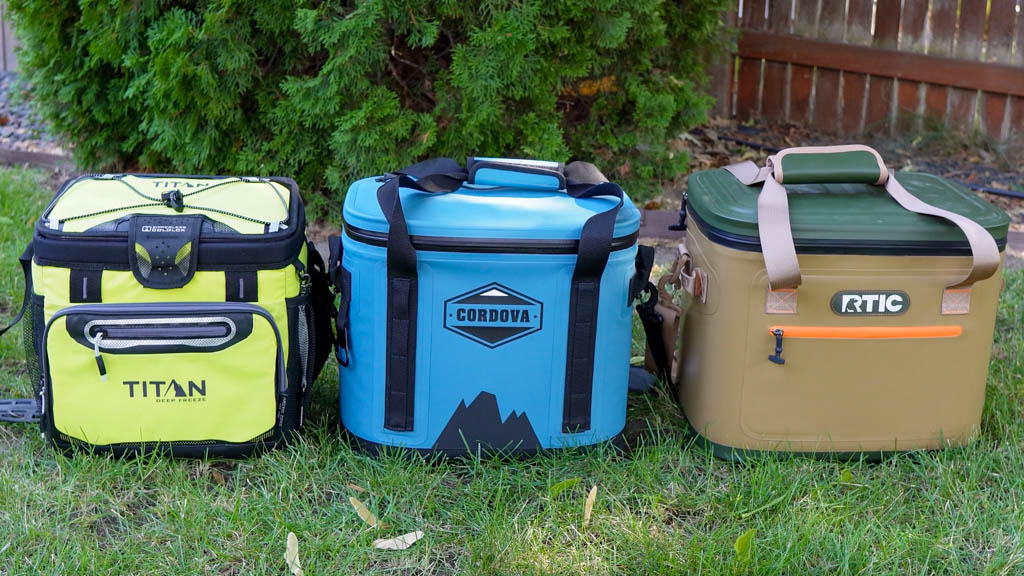
The main drawback is the one-year warranty with a 30-day registration requirement and several exclusions. However, in my blind customer service test, Cordova was responsive and helpful, so hopefully they won’t put up a fight if an issue arises.
Who should get this? Folks who want a grab-n-go day cooler or something compact for overnight trips. If you want to save ice and money compared to a YETI or an RTIC, consider this Cordova. But if you just want a cheap soft cooler, consider the Titan by Arctic Zone Zipperless Hardbody Cooler.
9. Best Backpack Cooler
ICEMULE Pro Large 23L
Compare Prices: Sportsman’s Warehouse, Bass Pro Shops, Cabela’s, Academy Sports, Camp Saver
Outdoor Empire Score 4.4
Ice Retention 4 | Build Quality 5 | Durability 5 | Features 5 | Warranty and Service 3
Pros
- Highly abrasion-resistant
- Ultra portable
- Mega durable
- Surprisingly effective ice retention
Cons
- Laughably short warranty
- Heavy when fully loaded with ice and beverages
If you want mobility, the ICEMULE Pro Large 23L backpack cooler is your go-to. It’s rugged TPU-coated polyvinyl material, the same used for whitewater rafts and paddleboards, is highly resistant to abrasion, making it ideal for hiking through trees and rocks. Instead of fail-prone zippers, it uses a roll-top that doubles as a handle. From my experience, the cooler is watertight and won’t leak ice water on your back, though sometimes that might be refreshing.
In my summertime test, the ice lasted for an impressive 2.5 days. At a family reunion, I planned to use it as a day cooler but ended up relying on it as overflow cold storage for a few days because it stayed so chilly. The comfortable shoulder and sternum straps make it suitable for extended day hikes. There’s no pocket, but the bungee straps can hold a towel or jacket. Plus, it sits flat on the ground instead of tipping like other top-heavy backpack coolers.
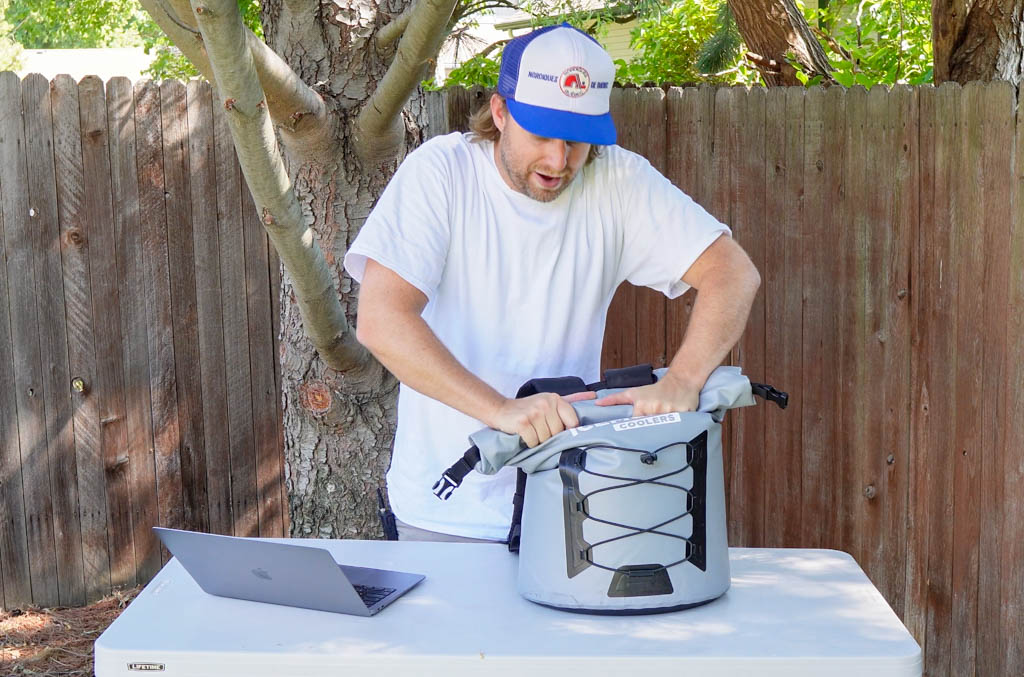
However, it gets heavy when fully loaded and there’s no waist belt to take the weight off your shoulders. The short 90-day warranty is also disappointing when they’re marketing a high-quality, durable piece of outdoor gear—ICEMULE should have more faith in their product.
Who should get this? People on the move who want a cooler you can take anywhere. It’s ideal for hiking, biking, boating, rafting, picnicking, or floating the river. An interesting alternative with rigid sides is the Engel BP25 backpack cooler.
10. Most Innovative Cooler
Oyster Tempo
Outdoor Empire Score 4.2
Ice Retention 4 | Build Quality 5 | Durability 3 | Features 4 | Warranty and Service 5
Pros
- Extreme thermal efficiency
- Gets cold super fast
- Stays cold longer than most
- Light and easy to carry
- Unique look and feel
Cons
- Expensive!
- Prone to lid damage
- Future of new company uncertain
The Oyster Tempo cooler stands out in our test fleet for its sleek appearance and exceptional cooling abilities. Made from aluminum, it cools faster than typical plastic coolers due to its conductivity. In addition to closed cel foam insulation, it employs Oyster’s vacuum-insulated DLTA system, similar to the double-walled metal tumblers that keep drinks cold for hours. By minimizing the gap under the lid, it reduces thermal bridging. All this technology results in faster cooling and longer cold retention. The lustrous design hails from Norway, where they know a thing or two about ice, aluminum, and aesthetics.
Despite being the smallest in our ice challenge, it retained ice for 12 days, outperforming 60% of the coolers tested, including those much larger with more thermal mass to throw around. In one test, it dropped below 40°F (food-safe) in just 38 minutes using only two ice packs that Oyster pretentiously calls ‘thermal batteries’ 🙄. Its rapid cooling eliminates the need for pre-chilling, which is recommended for massive rotomolded coolers that need to cool themselves before they can keep their contents cool.
I also tested it without ice, starting with food straight out of the fridge. For the results, watch my full Oyster Cooler review on YouTube!
While that high price is out of reach for most folks, this cooler is unique. With only a 1:2 ice-to-can ratio, the inverse of standard recommendations, it kept a couple dozen sodas icy cold for me during a multi-day camping trip. I like how the lid opens from either side and ensures an airtight seal. Its lightweight, compact size is perfect for those with limited space.
While the aluminum will eventually dent, and I might cry about it, it’s generally durable. Though the thin metal rim around the lid looks vulnerable and might compromise the seal if damaged. The lifetime warranty is reassuring, provided this startup stays in business.
Who should get this? Gearheads with extra cash and space-conscious individuals. Ideal for short trips, van life, and taking drinks to a bonfire, it’s not suited for a family’s week-long backcountry camping trip. For a more practical option with similar capacity, consider the Coho above. You can even save some money and go with a full-size rotomolded cooler like the Maluna.
How We Tested Coolers
When we evaluate gear at Outdoor Empire, we start by selecting a set of criteria based on research and our own experience in outdoor recreation. I’m not a scientist and I recognize that any gear testing involves some subjective opinions and biases, but we do this in a diligent effort to be as objective as possible when we compare similar gear against each other. This way, regardless of personal preference or how we acquired a piece of gear, we can give our honest assessment of it.
For each criterion we give a score between one (lowest) and five to each cooler. These scores are generally assigned based on the relative performance among all the products tested, but sometimes we deduct a specific number of points if a certain attribute or standard is not met. The average of the combined scores is the Outdoor Empire Score we use as our primary ranking factor.
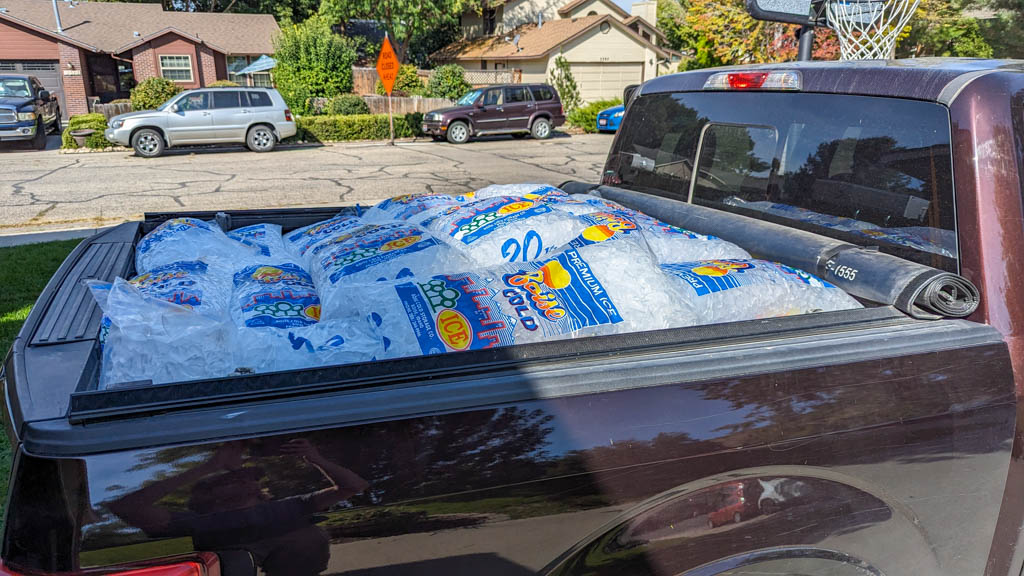
The five criteria we use to test, score, and rank coolers are as follows:
- Ice Retention: Given this is the primary function of a cooler, our ice retention tests consume a huge amount of our time and effort. We have conducted two large ‘ice challenges’ (28 coolers in 2022 and 38 in 2023) and several smaller ones where we purchased hundreds of pounds of ice that we dispersed among the test coolers. We left the coolers outdoors as if on a camping trip and we recorded results until all the ice melted. We made four daily pass/fail observations for each cooler including: ice presence (visual), soda cans on top of ice (visual, indicates volume of ice to water and surface tension), internal temperature (infrared thermometer reading at or below 50°F), and food temperature (pin thermometer reading in hot dog at or below 40°F). Each cooler received one point for each passed test each day and was eliminated the first day it received zero points. The number of full days with ice present was also recorded for each cooler.
- Build Quality: This is largely a qualitative evaluation of the fit, finish, feel, flaws, components, construction, and materials used, relative to other tested coolers in the same category.
- Durability: We assess the damage sustained by a cooler following regular use as well as some simulated real-world torture testing such as a cooler falling off a truck. In addition, one point was deducted if a cooler was not IGBC bear-resistant certified and one point was deducted if the construction type was not injection or roto-molded. The durability score is meant to be relative to coolers in the same category (hard, soft, etc.).
- Features: This is also a relative, qualitative assessment. We look at the number and utility of features (e.g. rod holders, rails, tie-down points, included accessories, add-on availability, clever design elements, rulers, etc.) relative to other coolers in the same category. This applies to features beyond the basics (e.g. lid, carry handles, drain, keeps things cold).
- Warranty and Customer Service: Half of the score is based on the warranty (2.5 points for 10 or more years, 2 points for 5 years, 1 point for 1 year, 0 points for less). The other half of the score is for the quality and responsiveness of customer service relative to other cooler companies (2.5 points for great service and multiple ways to contact, 0 points if impossible to contact, 1+ point for multiple ways to contact, possible lenience for good online support, 2 points if successfully contacted with acceptable response time and quality).
Why You Should Trust Us
I have spent hundreds of hours researching, acquiring, using, testing, and abusing ice chests. Hundreds of photos, dozens of hours of video footage, and more spreadsheets than I can recall have been collected to track, rank, and analyze coolers from nearly 40 different brands.
I personally make a concerted effort to use different coolers for all of my own outdoor adventures, which has brought to light little details and insights I may have missed from group testing and evaluation. From camping to hunting, fishing and sporting events, I’m the guy that shows up to every event with a different ice chest than the last.
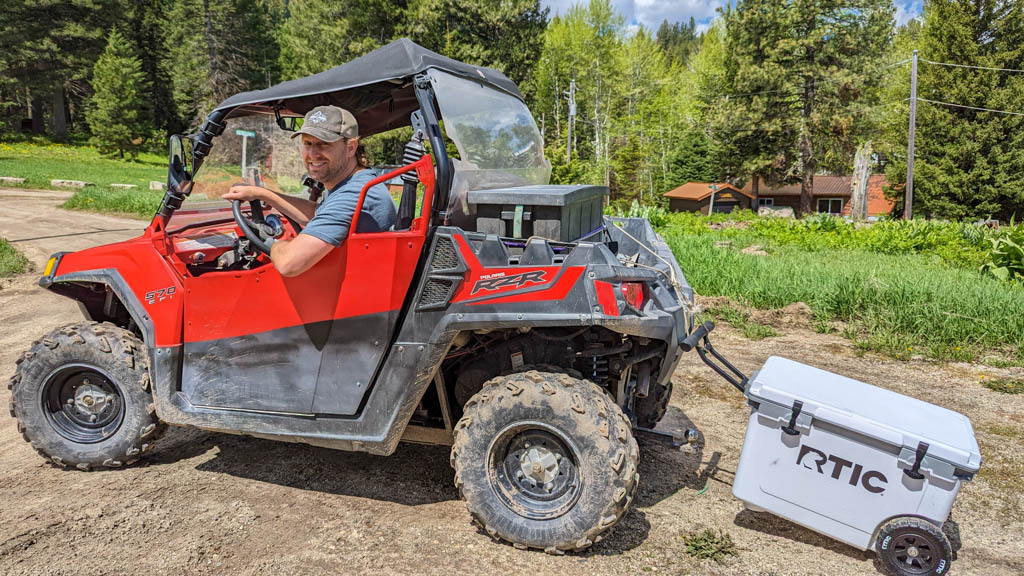
My educational background is in Geography and business. I have an MBA, a highly analytical mind, and extensive experience in product management at a tech company where I worked closely with engineers to identify customer pain points and come up with solutions to fix them. I’m an avid outdoorsman and have been camping since I was a baby. I notice things that others don’t and when I finally do stop researching a piece of outdoor gear I’m gonna buy for myself, I know exactly what I’m getting.
I obsess over coolers so you don’t have to. While my wife tells me it’s a problem, it pangs me to accept that there are still cooler brands out there I haven’t ice and torture tested just yet. On my quest to find the best, I dare say that I have spent more time and money than even the largest websites that appear at the top of the Google page when you search for ‘best coolers’.
For this review, I put in dozens of hours researching coolers online, at tradeshows, and in retail stores. As contenders were accumulated I used them in the real world out camping, hunting, picnicking, and doing the things people do with ice chests. I came up with both reasonable and ridiculous tests for evaluating durability and features. I even anonymously contacted every cooler company’s customer service department with the same question to evaluate their response time and helpfulness.
The results were chilling. 🥶😂 No cooler came out unscathed, but those with the best overall performance and quality are the ones that appear in this review.
How to Choose Your Next Cooler
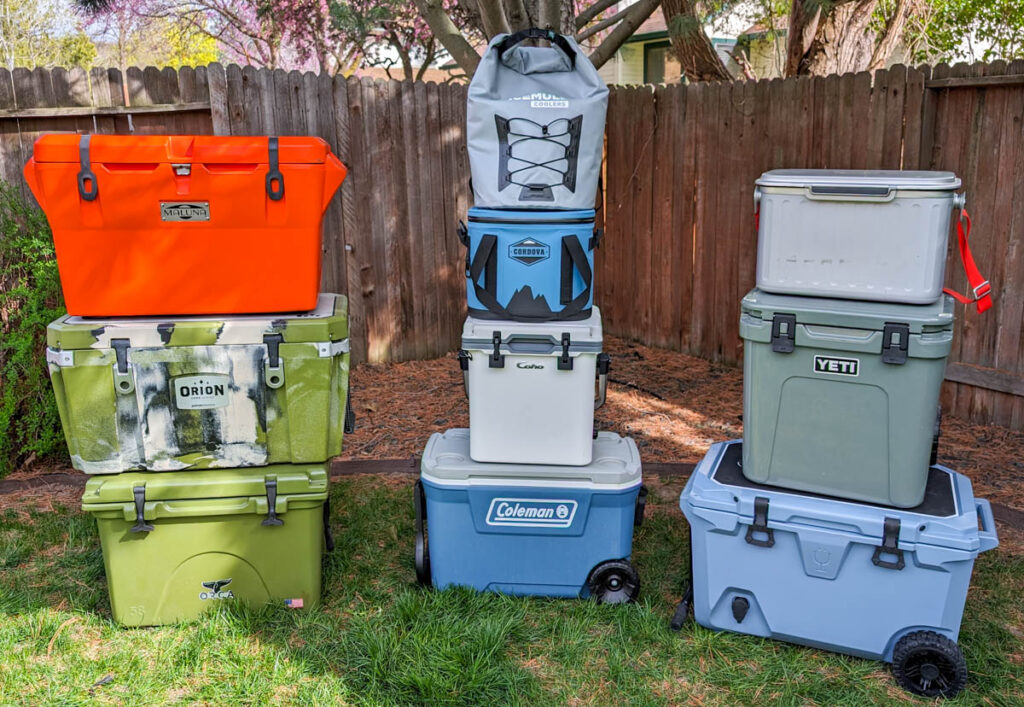
If you’re a regular camper or a backcountry hunter, a cooler could be one of the most expensive pieces of gear in your kit. Since YETI made coolers cool (in both meanings of the word), dozens of small companies have followed suit making rugged rotomolded coolers with hopes of high profits. Some are little more than copy cats while others add bells and whistles to differentiate themselves, like that goth kid in middle school.
The truth is, for the way most people use coolers most of the time, those fancy coolers are overkill. Honestly, that Coleman cooler listed above is probably sufficient for 80% of people out there, including myself. But then, people like myself like to have thoughtfully designed, high-quality outdoor gear instead of the run of the mill.
So here are some things you ought to look for in a new cooler. Just keep in mind how you want to, but especially how you actually will, use your future cooler.
Insulation and Ice Retention
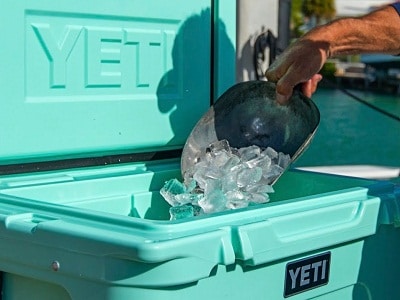
When you’re shopping around, knowing what kind of insulation lies between the walls of a cooler can help.
- Dense, closed cell polyurethane foam insulation is what the best brands use. It’s sprayed in the cooler shell wet and as it expands, it bonds to the internal plastic walls of the cooler. This helps eliminate voids and push out much of the air, replacing it with dense foam insulation with a high R-value. It’s relatively rigid and water-resistant.
- Open cell foam insulation is often used in less expensive and soft-sided coolers. While it’s also made of polyurethane, the chemical process is different and the result is a less dense foam material that incorporates more air. It’s generally more ‘squishy’, less water resistant, and less dense. That’s why it works for a small soft cooler that is watertight and only really intended to keep things cold for a day or so. But it may be a form of cost-cutting if found in larger hard coolers.
- Styrofoam or extruded polystyrene (EPS) is lightweight with decent insulation capabilities, but it’s made up of 95% air and can more easily crack or break down inside your cooler, like how a foam coffee cup breaks. Polystyrene does not insulate an ice chest as well as polyurethane and is less common now than it used to be, other than those cheap disposable coolers you get at the gas station in a pinch.
- Some of the cheapest coolers just have an air gap between a blown plastic lid or body. This is indeed better than wrapping your food in newspaper, but not by much.
The fundamental feature of a cooler is its ability to keep food cold. Many modern coolers express the quality of their insulation by stating how long it will keep ice fresh, but everyone has their own method and a theoretical lab test doesn’t necessarily reflect how you actually use a cooler on a camping trip.
That’s what I try to simulate in my ice retention challenges and you can see the results here. I left the coolers in my backyard, opened them every day, and monitored what happened. But you should still probably shave off a margin from the results I got based on weather in your region and how often you open it. When we’re out camping, my daggum kids will be in there every 30 minutes looking for a snack, letting warm air in every time.
Besides solid insulation, a rubber, freezer-style gasket will make a world of difference in ice retention. High-end coolers should always have an air-sealing gasket, cheap coolers usually won’t. You want to eliminate warm air from sneaking in your cooler and killing your ice. However, that doesn’t mean a cooler should be completely air (or water) tight. In fact, most coolers want to be dry ice compatible, which requires a way for carbon dioxide to escape, lest your cooler is a bomb. So a snug, supple gasket that allows a bit of one-way air traffic out is what you want.
Ask yourself, do you really need to have ice for 10 days?
Practically speaking, most people don’t require a cooler than can retain ice for an entire week, let alone two. While we use that as a primary ranking factor and the best coolers in this review will keep your food and drinks cold for several days even in the hot summer, if that doesn’t really matter to you, don’t fixate on it.
It’s worth noting that, while a $400 rotomolded cooler will keep drinks cold for days on end, if you just need to throw ice and drinks in a cooler for the baseball game tonight, they’ll probably be colder by then if you use the cheap Coleman. Why? Because heavy-duty coolers have a lot of mass and they have to cool themselves down first before they can cool the contents. Even if your drinks are cold going in, the cooler is going to zap some of that coldness from them before it reaches equilibrium and everybody’s cool.
That’s why YETI and other big cooler companies insist that you ‘pre-chill’ your cooler, meaning put a bag of ice in there 24 hours before you need to actually use it. When you’re ready to pack up, you drain off the excess water (just this once). Then they want you to add your food in cold too, straight from the fridge or freezer. Doing that will indeed start your trip off icy cold and likely stay cold longer.
BUT…
This is why that aluminum Oyster cooler is so impressive with its rapid cooling superpower. It’s the best option if you need cold drinks within a couple hours, not a YETI or a Maluna.
I digress, let’s move on.
Size
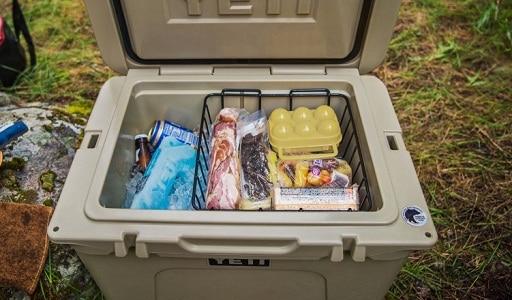
Cooler size matters both for the amount of storage available and the amount of space required to store and transport the cooler itself. Storage space is usually advertised in terms of quarts or the number of 12-ounce cans it can carry. Here’s my take on cooler sizes:
- 15 quarts or less: Good for your lunch and that’s about it.
- 15-30 quarts: Small coolers that are good for a day, drinks, or an overnighter as a couple. Great to have as a second cooler.
- 30-50 quarts: Medium coolers that are good for an overnight campout with a family, or longer trips for a couple. Great for beach days, parties, or a truck cooler stocked with lunches and cold drinks.
- 50-75 quarts: Large coolers that serve most needs of most people. This is the sweet spot that will usually work for anything from supplying your kid’s football team with Gatorade and Gogurt, to a weeklong camping trip for a family of five. This is what I use the most. It’s chock full for long campouts, but it’s got extra capacity on shorter trips. If you only get one cooler, this is probably the size range to get.
- Over 75 quarts: I consider these extra-large coolers and people that need a cooler of this size should have a good reason in mind for it. Packed full of food and ice large coolers like this will stay colder longer than their smaller counterparts. But if you only use half the capacity, it’ll be full of air and burn through ice like crazy. Big time hunters, whitewater rafters, and big families might go this route. Just know that they take up a ton of room in the garage and the truck too.
Many coolers have a number in the model that corresponds to size, but sometimes that number is arbitrary. If you’re set on a 70-quart cooler, read the specs to ensure it’s really 70 quarts. Brands like Maluna and Orion use the true internal capacity in their model names, while brands like Engel and YETI don’t. Sometimes the capacity listed is actually the volume of the entire cooler’s outer shell.
Overall size and shape is important because you will need to store, transport, and at some point, move the cooler. Too small, and you will be unable to store everything necessary for your trip. Too large, and the cooler will be unwieldy, too heavy, or might not fit into your car, tent, etc. I find more squarish shapes like the Orca are easier to fit in the back of an SUV (more stable to stand and fish from too). Some are too tall to fit under the tonneau cover of a pickup. So take some measurements of where you want to store it before you go for it.
For example, the Igloo Trailmate is a fun cooler, but it’s massive and takes up the entire cargo area of my Honda Pilot. So much for bringing chairs to the beach too.
Also note that you lose a fair amount of space to ice or ice packs. If it’s just for the day you may get away with a single bag of ice and have plenty of space in your 55-quart BruTank for drinks and snacks. But if you’re going camping in the boondocks for a week, you’ll want to aim for a 2:1 ice to content ratio which means you have less than 20 quarts of space for food. So if long trips are on the agenda, a big ole’ cooler you will need.
Related: How To Pack a Cooler Properly (Drinks, Camping, Day Trips, Meat)
Construction Type
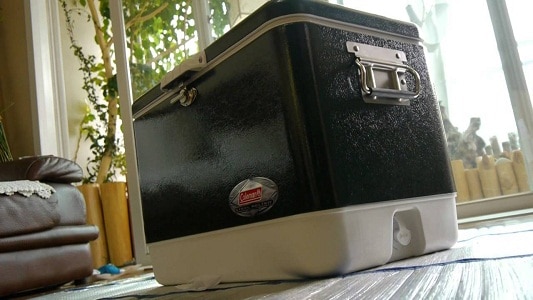
There is an ever-expanding list of options when it comes to what cooler materials, and scientists are constantly looking for the next lighter, more efficient material. However, for the purpose of this article, we will simplify matters and look at plastic, fabric, and metal coolers.
- Rotomolded
- Injection Molded
- Blow Molded
- Metal
- Soft-sided
- Plastic
This is the most common material used and the nearly exclusive choice for hard-sided coolers. However, there is one important aspect to remember—not all plastics are created equal. Both the very expensive and extremely inexpensive use plastic in their construction, and it all comes down to the manufacturing process used.
Fabric
Various fabrics have always been the choice when it comes to construction of cheaper, soft-sided lunch tote style cooler. Now, new stronger materials are being utilized to develop high-end brands as well. As new materials are developed or adapted their use in cooler will undoubtedly increase.
Metal
There was a time when metal, usually lined with an insulating material or consisting of two vacuum sealed layers, was the material of choice for cooler. Today, it is the exception. Although metal does allow for a very durable, long-lasting design, it is heavy and has been largely replaced by plastic.
Portability
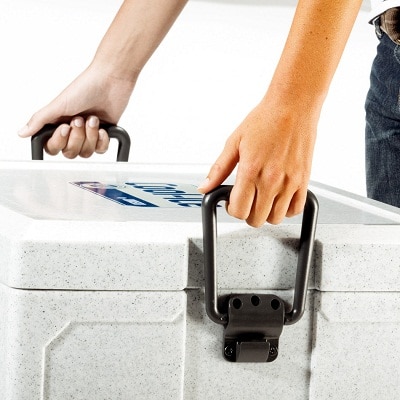
Portability is a big deal for many cooler shoppers and the most portable coolers are either lightweight, compact, and no fun, or they have wheels.
If you are shopping for your first cooler you probably think that portability comes down to three simple features—smaller size, wheels, and large, easy-to-use handles. However, making a decision based on those criteria alone will likely lead you to be disappointed.
A small, lightweight cooler is of little use if it has such a small capacity that it barely holds lunch, never mind a weekend’s worth of steaks, corn on the cob, and beer.
Likewise, how likely is it that those tiny, hard plastic wheels that allowed you to speed across the driveway will perform even half as well in the sand or mud?
Next, you need to consider how uncomfortable or difficult it may be to actually use. Is it too bulky to load into and unload from the car? Are the handles placed to allow for a good grip when carrying it alone?
Ease of Use
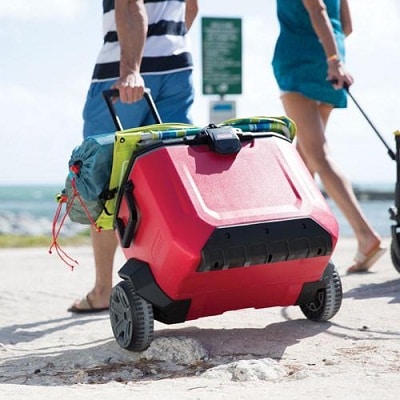
It is hard to believe that ease of use would even be a concern when it comes to a cooler, but advancements have resulted in coolers with a wide array of features never before available, and each added feature means a higher degree of difficulty for the user.
The first order of business when reviewing ease of use are the general features available on any cooler—size, shape, handles, and wheels (if included).
Can you load it easily and efficiently? Does the size allow for loading common items, and is it easy to carry? Are the handles adjustable? If so, how hard is it to adjust them? Do the wheels provide a smooth, easy-to-pull platform?
All these things you should wonder when buying any cooler. But then things get a little more complex as you dig a bit deeper.
Improved seals and latches are required for multiple days of ice-cold temperatures. There are a variety of latch designs in use, including large rubber models that are stretched into place, push-button locks, and even slide latches. Eventually every cooler loses its cool and ice melts, so there has to be a drain available.
Some of these drains are simple plugs—pull them out and let the water run. Others involve multiple discs that need to be turned, lined up, etc. Each manufacturer is convinced their design is best, but some are far more difficult to use.
Accessories

With all the advanced features available in today’s cooler, it is almost mind-blowing to think that there is the possibility of even more optional accessories. But there are plenty of options to upgrade the “best cooler” and make it even better.
So, if you are the type of person who is always looking to make improvements, it is important to consider what upgrades may be available. Examples include dry trays to keep items off the ice, interior/exterior storage compartments, cup holders, bottle openers, and even measuring tapes (once a common feature on the lid of any cooler).
Some wheeled models offer upgraded wheels for use off-road or on the sand. There are even models that offer a handle replacement that allows the cooler to be towed behind a bicycle.
Other features
Although not features that usually distinguish a specific brand, there are some features that can be a tie-breaker when two models are up for consideration. What colors are available? Does it include a warranty? If so, what are the terms of it?
Analysis and Test Data
Before I met the Maluna, the Orion Core 65 was the cooler to beat. It handily won the first ice retention challenge I did (actually tied with the Cabela’s) in the heat of summer making it 9 full days with ice when daytime highs were teetering around 100 degrees.
Frequently Asked Questions
Why Do I Need a Quality Cooler?
A quality cooler will not only store and protect your food and drinks, it will also maintain a consistent food temperature at or below 40°F.
This is the temperature at which food-borne pathogenic bacteria starts to thrive, so a cooler that keeps food and drink below this mark helps to protect you from illness.
A quality cooler will also offer features or accessories that make it easier to use. Some are even specifically designed to accommodate specific tasks, such as boating, camping, or fishing.
Recommended reading:
How to Properly Clean and Maintain a Cooler (Even Stains and Smells)

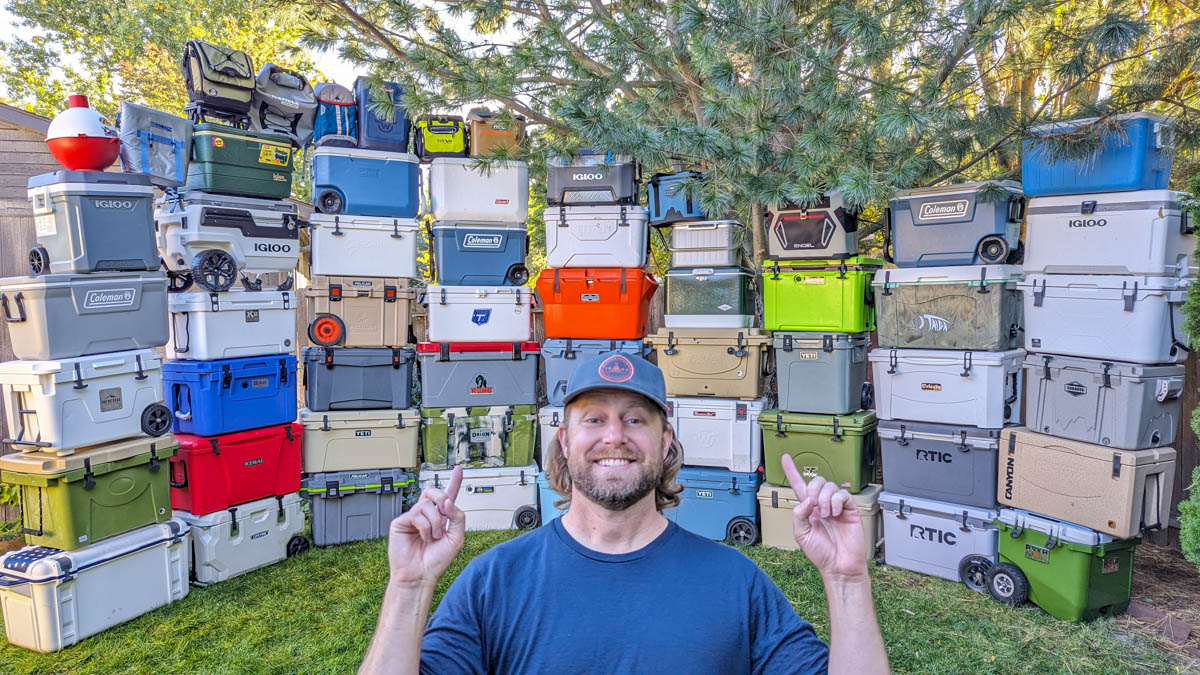
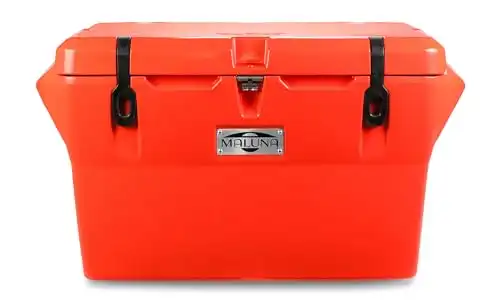

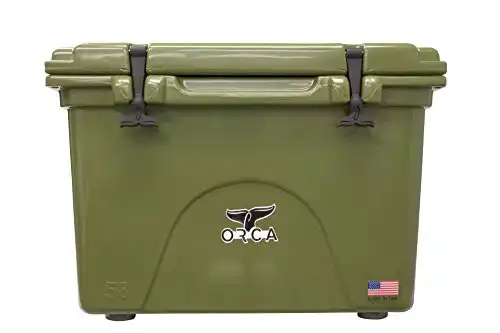

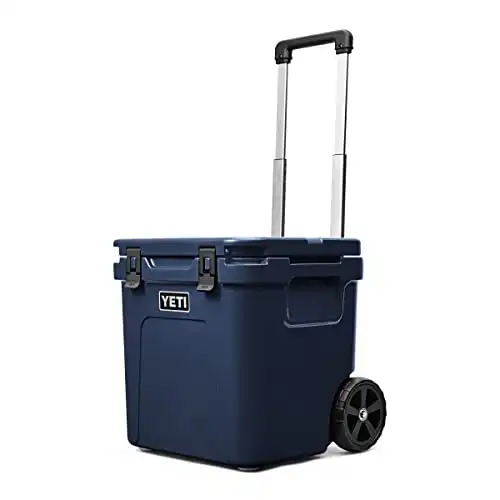

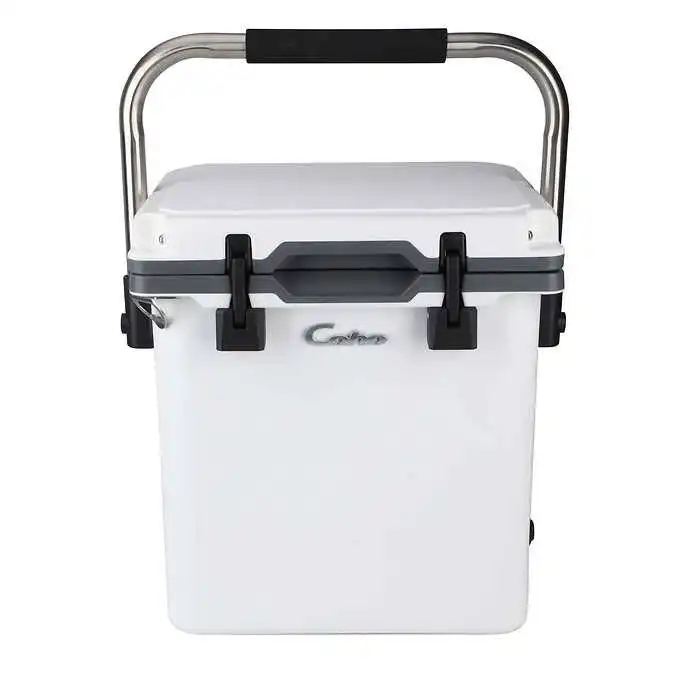
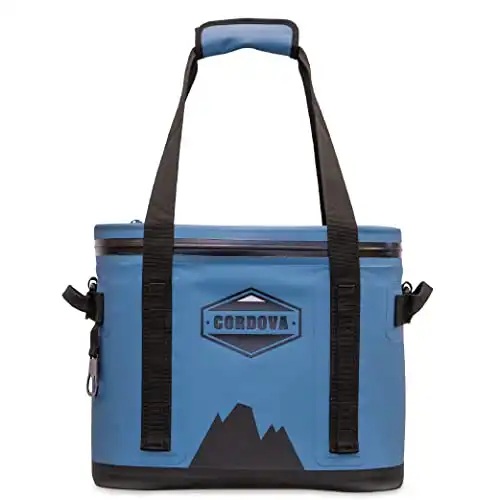

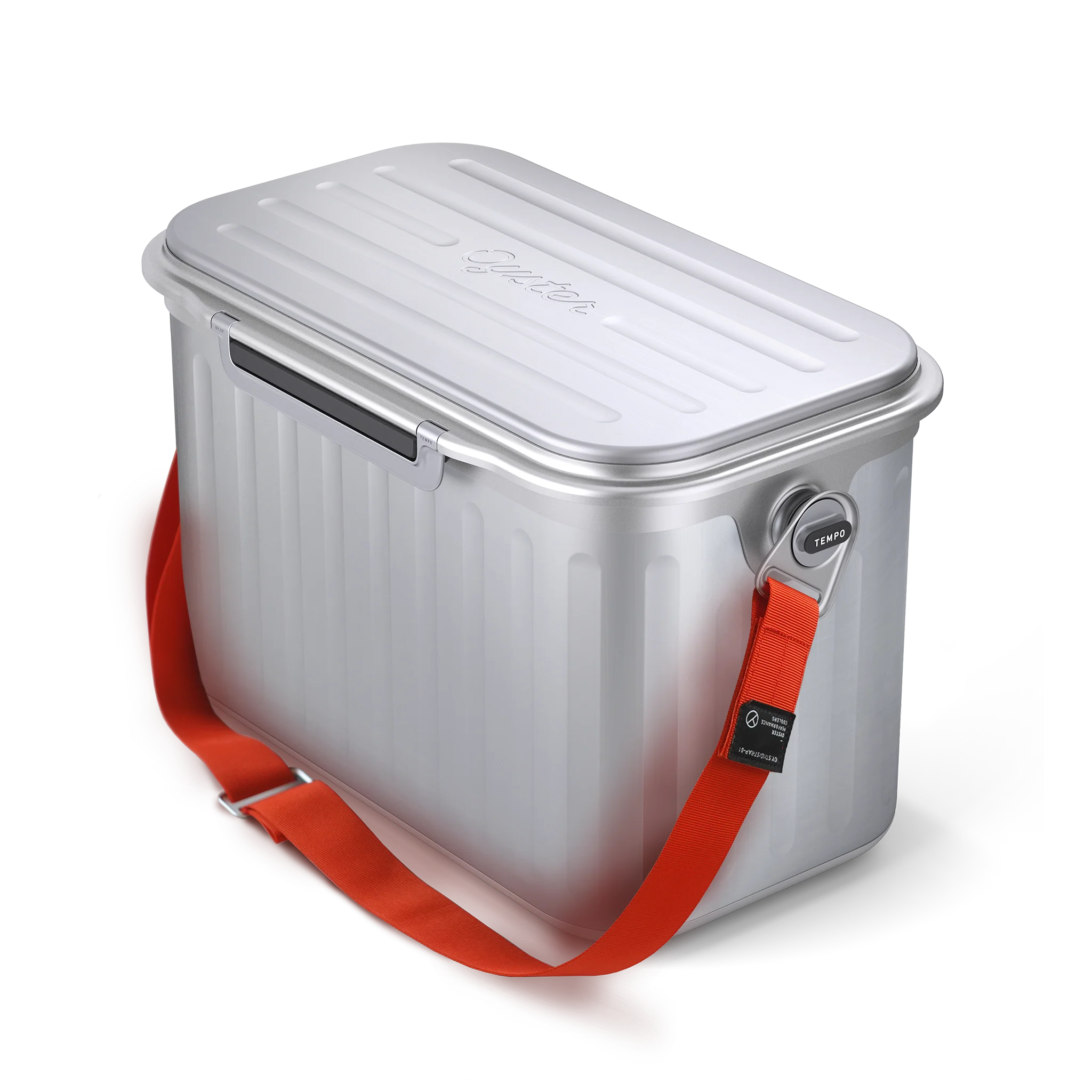



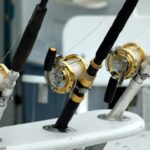
Comments are closed.